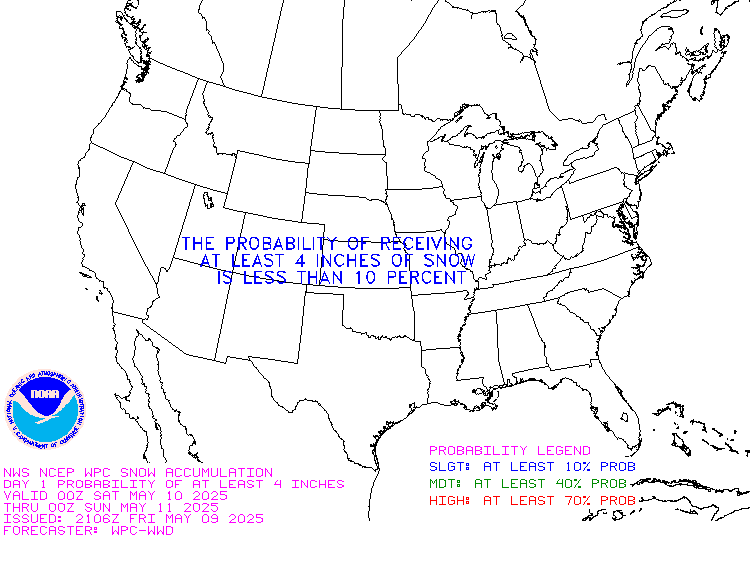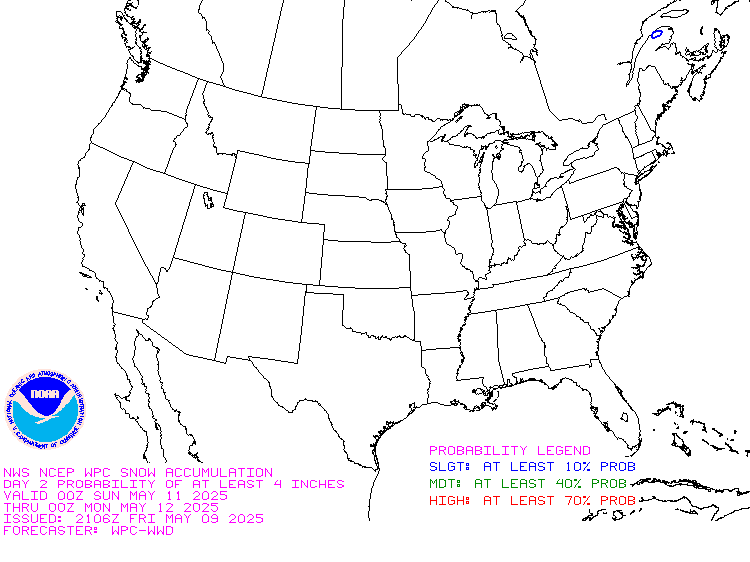It is difficult to find a more comprehensive Weather Outlook anywhere else with the ability to get a local 10-day Forecast also.
This article focuses on what we are paying attention to in the next 48 to 72 hours. The article also includes weather maps for longer-term U.S. outlooks and a six-day World weather outlook which can be very useful for travelers.
First the NWS Short Range Forecast. The afternoon NWS text update can be found here but it is unlikely to have changed very much. The images in this article automatically update.
Short Range Forecast Discussion
NWS Weather Prediction Center College Park MD
Tue Feb 27 2024
Valid 12Z Tue Feb 27 2024 – 12Z Thu Feb 29 2024…Heavy snow returns over parts of the Cascades, the Northern
Intermountain Region, and Northern Rockies on Wednesday……Heavy snow over parts of the Upper Mississippi Valley and moderate to
heavy snow over the Cascades to Central Rockies on Tuesday……Light to moderate snow over the Great Lakes, Central Appalachians, and
Northeast on Wednesday……There is a Slight Risk of severe thunderstorms over parts of the Ohio
Valley/Great Lakes on Tuesday…A strong winter storm and cold front will continue to progress through the
West, reaching the Central Rockies on Tuesday. Furthermore, the storm will
create near-blizzard conditions, resulting in dangerous travel. Snowfall
rates of 1-2 inches per hour will move into the Great Basin and Central
Rockies on Tuesday. These snow rates combined with winds gusting 50-65 mph
will produce near-blizzard conditions with significantly reduced
visibility and snow-covered roads leading to dangerous travel. Further,
significant snow accumulations will occur across the Colorado Rockies
southward into the San Juans and Sangre de Cristos; there is a high chance
(greater than 70%) of more than 8 inches of snow in the higher elevations.In addition, widespread snow squalls are expected to develop along the
path of the cold front from Utah to Wyoming and Colorado on Tuesday. Where
snow squalls occur, intense snow rates will produce rapid drops in
visibility and icing on roadways, resulting in dangerous travel.In addition, much colder air will move in behind the strong cold front.
Temperatures will fall into the teens and single digits Tuesday morning
throughout the Intermountain West.Another powerful storm will move over the West, producing a significant
winter storm over the Pacific Northwest late Wednesday into Thursday, as
heavy snow returns to the Northern Cascades and Northern Intermountain
Region.Meanwhile, on Tuesday, a front extending from the Upper Great Lakes to the
Central Rockies will create heavy snow over parts of the Upper Mississippi
Valley and moderate to heavy snow over the Upper Great Lakes. Ahead of the
front, southerly wind will bring warm temperatures of 15 to 30 degrees
above average to the Southern Plains to the Great Lakes. The warm and dry
conditions with gusty winds across the Southern Plains have resulted in an
Elevated Risk of Fire Weather (level 1/3) from the Storm Prediction Center
on Tuesday.Additionally, moisture from the Western Gulf of Mexico will stream
northward over the Southern Plains, Middle/Lower Mississippi Valley, and
Ohio Valley. The moisture will aid in creating showers and severe
thunderstorms over parts of the Ohio Valley. Therefore, the SPC has issued
a Slight Risk (level 2/5) of severe thunderstorms over parts of the Ohio
Valley, Middle Mississippi Valley, and Great Lakes through Wednesday
morning. The hazards associated with these thunderstorms are frequent
lightning, severe thunderstorm wind gusts, hail, and a few tornadoes.
Further, there is an increased threat of hail two inches or greater over
parts of southwestern Michigan, most of Illinois and Indiana, plus
southeastern Missouri.Moreover, as the robust front moves across the Great Lakes to the East
Coast, moderate to heavy snow will develop over the Great Lakes into the
Northeast, with light to moderate snow over the Central Appalachians on
Wednesday into Thursday morning. Ahead of the snow, showers and
thunderstorms will develop over parts of the Northeast. The boundary will
also create showers and thunderstorms over parts of the Eastern Ohio
Valley, Central Appalachians, into the Mid-Atlantic and Southeast.Elsewhere, upper-level energy moving into the Southwest and Southern
Rockies will produce scattered showers and thunderstorms from Wednesday
afternoon into Thursday morning.
To get your local forecast plus active alerts and warnings click HERE and enter your city, state or zip code.
Above is a 72 hour animation of the forecast. Learn about wave patterns HERE.
Then, looking at the world and of course, the U.S. shows here also. Today we are looking at precipitation.
Please click on “Read More” below to access the full report issued today.
| Notices: What would you like to learn about? Please provide that to me via the comment section at the end of the article. |
Now more detail on the 48-Hour Forecast (It is a 48 to 72 Hour Forecast actually)
Daily weather maps. The Day 1 map updates twice a day and the Day 2 and 3 maps update only once a day. These maps update automatically. But if that does not happen, you can get updates by clicking HERE
TODAY (or late in the day the evening/overnight map will appear) (Key to surface fronts shown on maps and you will then also be able to insert a city name or zip code and get a local NWS forecast).
TOMORROW
NEXT DAY
This animation shows how things may play out over the next 60 hours. To update click here.
The NWS Climate Prediction Center’s: Watches, Warnings, and Advisories plus other information can be found HERE. We post at least one of those updates daily, sometimes both. The Highlights are shown in the lede paragraph of this article.
ATMOSPHERIC RIVERS
This tells us what is approaching the West Coast. Click HERE to update If I have not gotten around to doing the update. Here is some useful information about Atmospheric Rivers.
Below is the current five-day cumulative forecast of precipitation (Updates can be found HERE)
Ski SnowReports
New Feature – Ski Reports. It is difficult to find reports that auto-update on-screen (and they are very long) but these links will get you to them – If you have additional suggestions make them in the comments section after every Econcurrents Article and we may add those links. We will try to not have too much overlap as that can add to the confusion.
Snow Forecasts. And remember this shows natural snow. Ski resorts also make their own snow.
Day 1

Day 2

Additional snow information can be found here, here, here, and here. The second link provides animations.
Now we look at Intermediate-Term “Outlook” maps for three time periods. Days 6 – 10, Days 8 – 14, and Weeks 3 and 4. An outlook differs from a forecast based on how NOAA uses these terms in that an “outlook” presents information as deviation from normal and the likelihood of these deviations.
Below are the links to obtain updates and additional information. They are particularly useful if you happen to be reading this article significantly later than when it was published. I always try to provide readers with the source of the information in my articles. These links may also be useful for those viewing this article on a cell phone or other small screen.
| Days 6 – 10 (shown in Row 1) | Days 8 – 14 (Shown in Row 2) | Weeks 3 and 4 (Shown in Row 3 but updates only on Fridays) |
| https://www.cpc.ncep.noaa. gov/products/predictions/610day/ | https://www.cpc.ncep .noaa.gov/products/predictions/814day/ | https://www.cpc.ncep.noaa.gov/products/predictions/WK34/ |
Showing the actual maps. They should now update automatically. The Week 3 – 4 Outlook only updates on Fridays. So below is what I call the Intermediate-term outlook. On Fridays, it extends out 28 Days. That declines day by day so on Thursday it only looks out 22 days until the next day when the Week 3 – 4 Outlook is updated and this extends the outlook by one additional week.
| 6–
10
|
|
|
| 8–
14 |
|
|
| 3–
4 |
|
|
HAZARDS OUTLOOKS
Click here for the latest complete Day 3 -7 Hazards forecast which updates only on weekdays. Once a week probably Monday or Tuesday I will update the images. I provided the link for readers to get daily updates on weekdays. Use your own judgment to decide if you need to update these images. I update almost all the images Friday Night for the weekend edition of this Weather Report. So normally readers do not need to update these images but if the weather is changing quickly you may want to.
Temperature month to date can be found at https://hprcc.unl.edu/products/maps/acis/MonthTDeptUS.png
Precipitation month to date can be found at https://hprcc.unl.edu/products/maps/acis /MonthPNormUS.png
World Forecast [that website is has been intermittent so be patient]
Below are the Day 1 -3 and 4-6 forecasts for temperature and precipitation. Updates and much additional information can be obtained HERE
World Temperature Anomalies
World Accumulated Precipitation
This information is provided by the University of Maine. They draw upon many different sources. There is a lot of information available at the link provided. I have just provided two useful forecasts. There are probably over a hundred different forecasts available from this source.
Worldwide Tropical Forecast (This is a NOAA Product)
This graphic updates on Tuesdays) If it has not been updated, you can get the update by clicking here Readers will only have to do that if they are reading this article much later than the date of it being published.
Information on Tropical Storms can be found HERE. Western Pacific information can be found HERE.
–
| I hope you found this article interesting and useful. |
–
